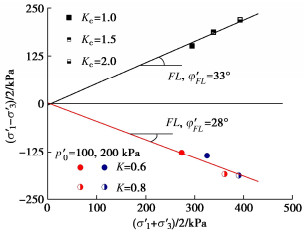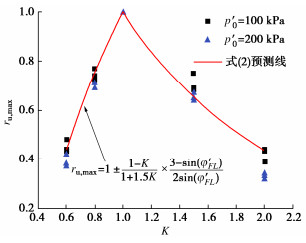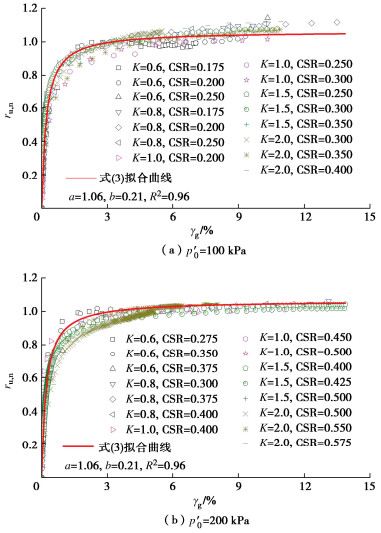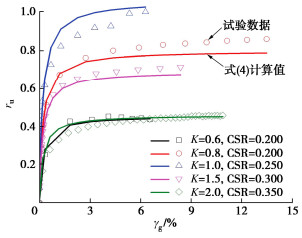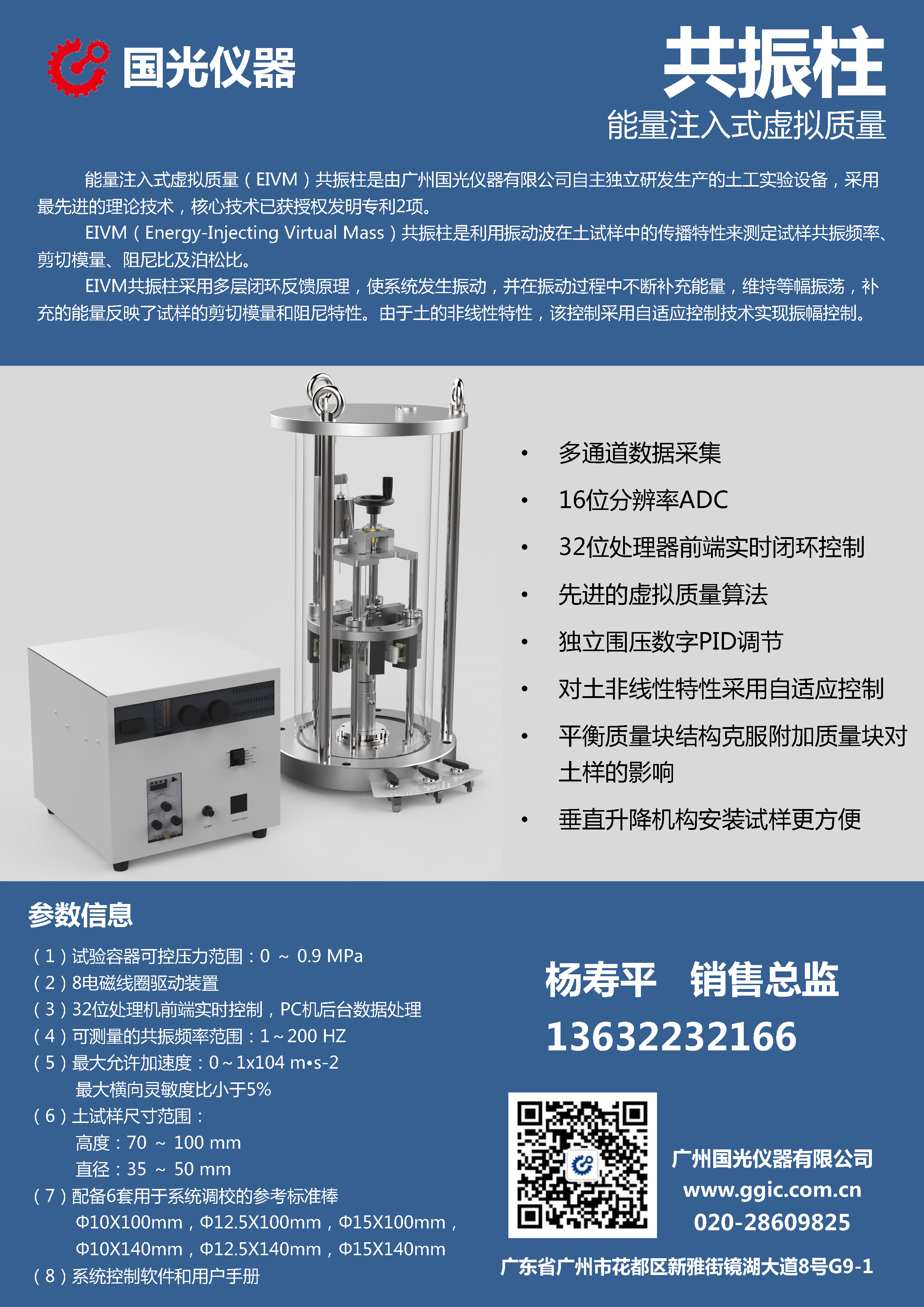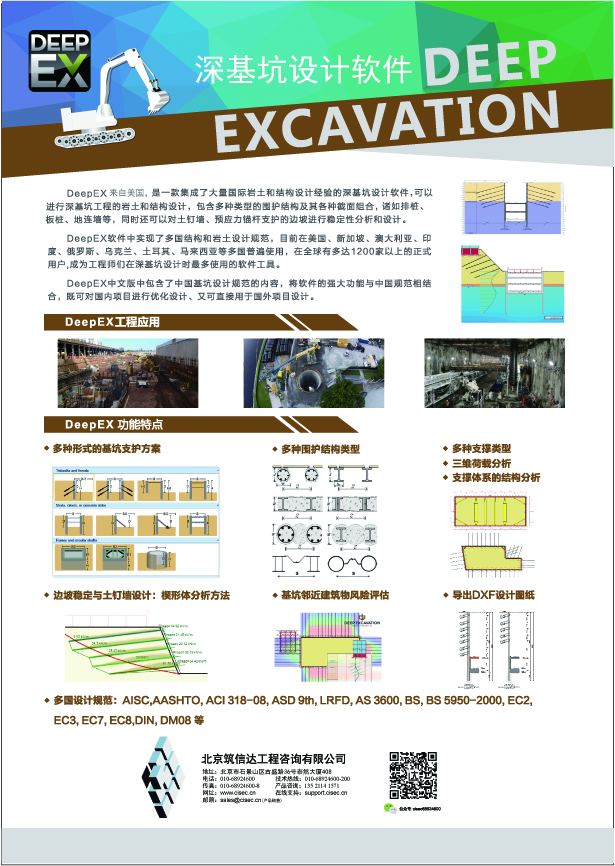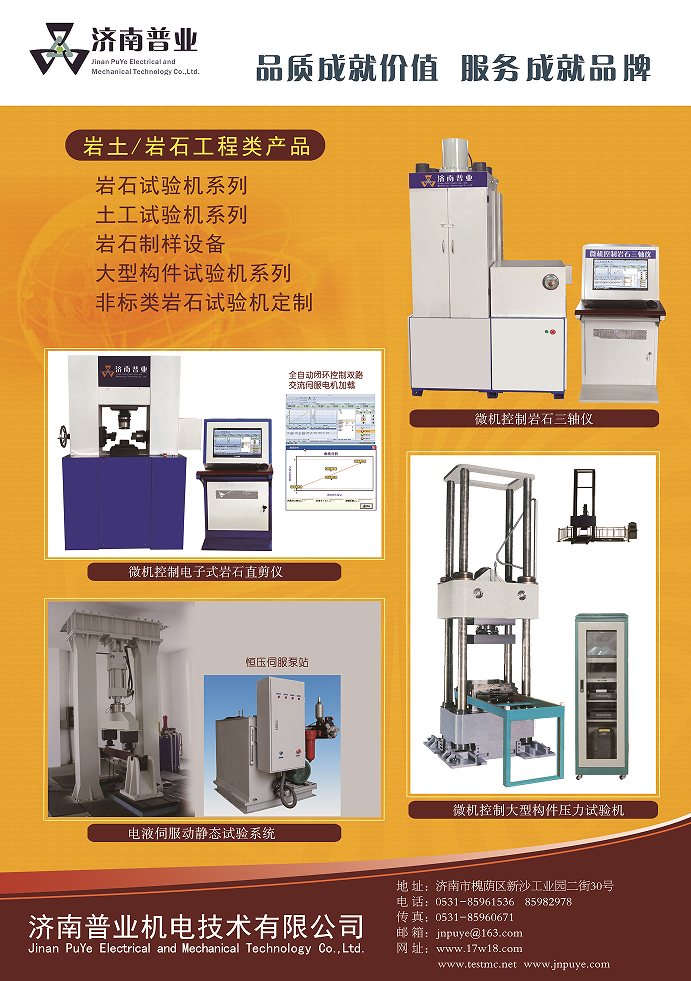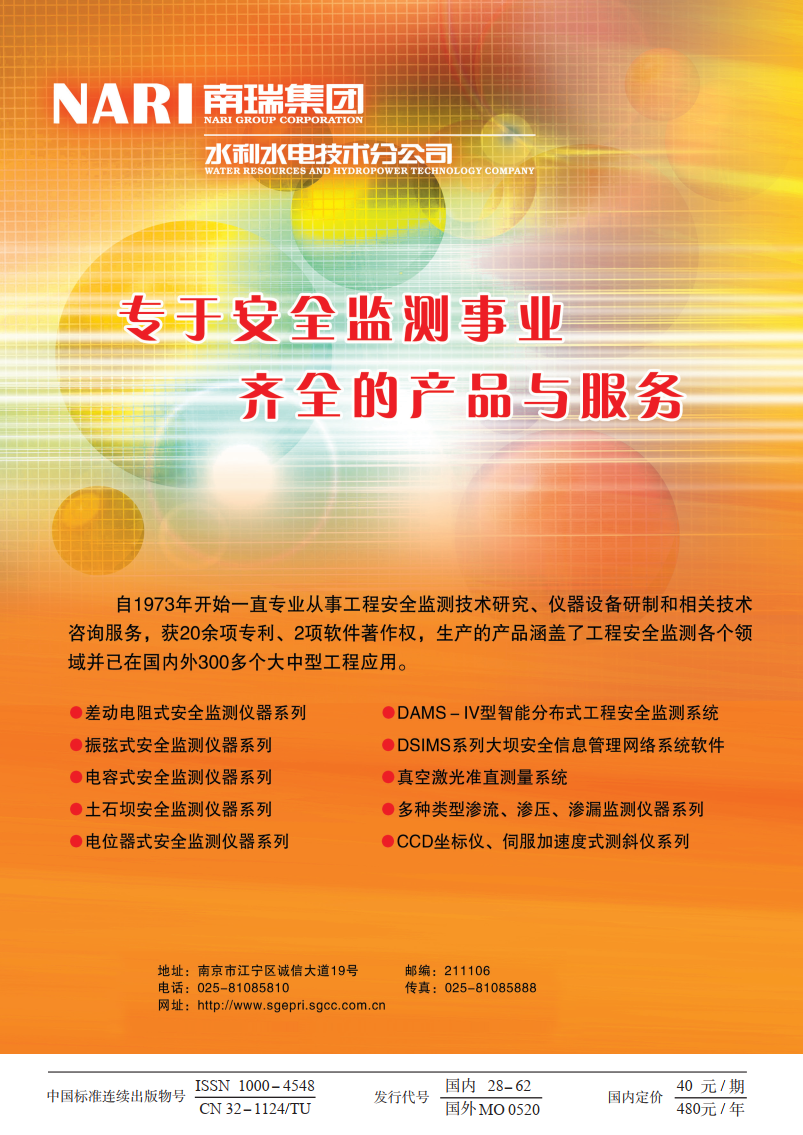Generalized shear strain-based model for development of excess pore water pressure in saturated sand under anisotropic consolidation
-
摘要: 各向异性固结条件下饱和砂土中超静孔隙水压力的发展规律对于理解砂土液化行为至关重要。使用空心圆柱扭剪仪进行了一系列扭剪试验,研究了初始固结条件(初始平均有效应力p'0、固结应力比K)和循环加载条件(循环应力比CSR)对饱和砂土的广义剪应变γg和超静孔压比ru发展规律的影响。试验结果表明,各向异性固结条件下的砂土表现出三类破坏模式:循环迁移、循环液化和残余累积变形。在所有3种破坏模式下,归一化超静孔压比ru, n都与γg相关。据此提出了考虑各向异性固结条件的饱和砂土超静孔隙水压力预测模型。该模型能合理预测不同固结应力状态下超孔隙水压力的发展。Abstract: The development pattern of the excess pore water pressure in saturated sand under anisotropic consolidation conditions is crucial for understanding the liquefaction behavior of sand. In this study, a series of torsional shear tests are conducted using the hollow-cylinder torsional apparatus to examine the influences of the initial consolidation conditions (initial mean effective stress p'0 and consolidation stress ratio K) and cyclic loading conditions (cyclic stress ratio, CSR) on the development patterns of the generalized shear strain (γg) and excess pore water pressure ratio (ru) in saturated sand. The experimental results indicate that the sands under anisotropic consolidation exhibit three failure modes: cyclic mobility, cyclic liquefaction and residual cumulative deformation. The normalized ru can be correlated with γg for all the three failure modes. A prediction model for the excess pore pressure is proposed considering the anisotropic consolidation conditions for saturated sand. The model can reasonably predict the development of pore water pressure under different consolidation stress states.
-
0. 引言
微生物诱导碳酸钙沉积(microbially induced calcite precipitation,简称MICP)是本世纪初提出的一项岩土工程实用技术,主要利用以碳酸钙为产物的微生物矿化过程,在岩土材料中形成类似水泥的胶凝材料,进而对岩土材料起到加固作用[1-2]。由于基于尿素水解的MICP技术具有反应过程容易控制、能够在短时间内产生大量CO32-、生成碳酸钙结晶的反应过程和胶凝强度容易控制以及所生成的结晶物在一定条件下可替代传统胶凝材料等特点[3-7],国内外研究人员通过开展天然岩石节理现场试验和模拟岩石节理室内试验对MICP技术封堵岩石节理的适用性进行了广泛研究[8-16],试验结果表明:采用MICP方法对岩石节理进行多轮次灌注后,由于MICP反应产生的碳酸钙沉积在岩石节理中导致其隙宽显著下降,MICP封堵后岩石节理渗透系数最大降幅达4个数量级,封堵效果良好。
尽管如此,Lambert等[17]针对加拿大南安大略地区地下16 m处水平灰岩裂隙开展原位激发MICP封堵试验,结果发现注入营养液52 d后灰岩裂隙导水系数最大降幅达62%,封堵效果较为理想,但是230 d后复测发现灰岩裂隙导水系数出现一定程度恢复,这表明岩体裂隙MICP封堵效果在复杂地下环境中可能出现退化。Minto等[18]针对固碳储层岩体CO2泄露问题,分析了Berea砂岩岩芯MICP封堵效果及所生成的碳酸钙弱酸性侵蚀情况,结果表明尽管Berea砂岩岩芯中优势渗流通道被MICP封堵,阻止了酸性地下水在岩芯中的渗流,抑制了碳酸钙侵蚀,但在岩芯边缘与酸性地下水接触的碳酸钙产生了明显侵蚀现象。上述研究成果表明耐久性是岩体MICP封堵需要关注的关键问题,同时由于MICP产生的碳酸钙封堵层对酸性环境较为敏感,酸性侵蚀是影响MICP封堵耐久性的最不利因素,因此抗酸性侵蚀性能是影响MICP封堵耐久性的关键因素。尽管近年来已有学者关注碳酸钙酸性溶蚀行为对MICP胶结砂土长期性能的影响[19-20],目前关于MICP封堵处理岩石节理抗酸性侵蚀方面的研究成果还鲜见报导。
鉴于此,本文以单一岩石节理为研究对象,开展MICP封堵岩石节理试件在不同PH值侵蚀溶液中侵蚀不同时间的酸性侵蚀试验,研究酸性侵蚀后MICP封堵岩石节理碳酸钙封堵层溶蚀情况及其在酸性侵蚀前后的渗透性演化规律,在此基础上分析岩石节理MICP封堵抗酸性侵蚀性能,为MICP技术在岩体封堵工程中的应用提供科学依据。
1. MICP封堵岩石节理试件
1.1 3D打印类岩石节理试件制备
由于本次MICP封堵岩石节理酸性侵蚀试验需要大量具有相同表面形貌特征的岩石节理试件,在此以人工劈裂花岗岩节理试件(平面尺寸长×宽=100 mm×50 mm)为原型,先采用三维激光扫描仪获取其表面三维形貌数据,构建人工劈裂花岗岩节理数字模型,再采用透明光敏树脂(型号Crysta-8QEF1)为打印材料,利用3D打印技术打印透明树脂类岩石节理试件,制备流程如图 1所示。固化后的透明光敏树脂表面无孔隙,几乎不吸水,物理特性与原型花岗岩近似。本次试验共打印了9组透明树脂类岩石节理试件(分别编号为1-1~1-9),用于后续MICP封堵试验和酸性侵蚀试验。
完整花岗岩基本物理力学参数、人工劈裂花岗岩节理JRC值以及透明树脂基本物理参数汇总如表 1所示。其中,完整花岗岩基本物理力学参数通过3组标准圆柱体花岗岩试件室内单轴压缩试验结果得到;人工劈裂花岗岩节理JRC值计算先利用表面三维形貌数据获得沿节理试件长度方向的节理剖面线二维坐标数据,再按照Tse等[21]提出的JRC计算公式计算:
(1) 式中:Z2为岩石节理剖面线坡度均方根一阶导数。
表 1 花岗岩和固化透明光敏树脂基本物理力学参数Table 1. Physical and mechanical parameters of granite and resin透明光敏树脂材料 花岗岩和花岗岩节理 邵氏硬度 弯曲模量/
GPa拉伸模量/
GPa拉伸强度/
MPa热变形温度/
℃密度/
(g·cm-3)单轴抗压强度/MPa 弹性模量/
GPa节理JRC值 76~82 2.57~2.86 2.49~2.6 44~60 40~51 2.586 155.0 9.0 11.56 1.2 3D打印类岩石节理试件MICP封堵处理
当3D打印类岩石节理试件制备好后,为了避免MICP封堵试验中试件入口因为碳酸钙沉积而造成堵塞,首先在节理表面4个角点处放置不同厚度小垫片形成具有不同隙宽值的岩石节理试件开展MICP封堵预试验,最终确定隙宽为2 mm时试件入口处基本不会发生堵塞。因此,正式MICP封堵试验中在节理表面4个角点处放置2 mm厚小垫片以形成隙宽2 mm的节理空腔,沿节理长度方向用纳米胶密封试件两侧,并在试件宽度一侧用纳米胶固定一个“Y”型接头作为MICP反应灌注入口,另一侧为灌注出口自然出流并贴上滤纸防止MICP反应生成的碳酸钙流出,密封好的3D打印类岩石节理试件如图 2所示。为了测试3D打印类岩石节理试件初始渗透系数K0,在进行MICP封堵处理前先采用如图 3所示装置对其进行沿节理长度方向的单向渗流试验,在此基础上采用立方定理估算其渗透系数,最终测得3D打印类岩石节理试件初始渗透系数K0为9.814×10-2 m/s。
3D打印类岩石节理试件MICP封堵试验采用单向非循环灌注方式,试验装置如图 4所示,包括蠕动泵、试件固定支架、连接软管、菌液和反应液储罐以及废液收集桶等。其中,试件固定支架具有角度调节功能,角度调节范围为0°~90°。本次试验菌种采用购自上海保藏生物技术中心的巴氏芽孢杆菌(编号为SHBCC D10472),菌种经活化培养后测试菌液OD600值为0.824。反应液采用1.0 moL/L等摩尔尿素-氯化钙混合溶液,其中尿素为细菌生长提供氮源和能量,氯化钙为MICP反应提供钙源。
岩石节理MICP封堵试验过程中,首先将固定支架调整为水平,将密封好的岩石节理试件置于支架上并接入蠕动泵,通过蠕动泵向岩石节理空腔注满菌液并静置2 h,保证细菌充分附着在岩石节理表面。然后开始菌液和反应液单向非循环灌注,灌注前把固定支架调整为向下倾斜一定角度,先以0.5 mL/min速率连续泵送菌液和反应液60 min,静置2 h;再以1 mL/min速率连续泵送菌液和反应液30 min,再次静置2 h;最后再以0.5 mL/min速率泵送菌液和反应液直至灌注入口处无法泵送或出现漏液情况,停止灌注。为了避免岩石节理空腔内部碳酸钙填充不密实,在岩石节理单向非循环灌注结束后将固定支架调整为向下倾斜90°,通过蠕动泵以0.3 mL/min速率泵入约20 mL菌液和20 mL胶结液并静置3 h,重复5次以保证岩石节理空腔能够被碳酸钙完全填充密实。
按照上述步骤得到的MICP封堵处理3D打印类岩石节理试件(以下简称“MICP封堵岩石节理试件”)如图 5所示,将其置于40℃烘箱中连续烘干72 h后取出冷却称重,再继续烘干6 h后重新取出冷却称重,若两次称重差值不超过3 mg,则认为试件中碳酸钙层已经完全干燥固化,可以用于后续酸性侵蚀试验,最终得到酸性侵蚀试验前9组MICP封堵岩石节理试件中碳酸钙质量(记为M1)数值汇总如表 2所示。此外,MICP封堵岩石节理试件在进行酸性侵蚀试验之前先接入图 3所示自制渗流试验装置,测试试件在MICP封堵后的渗透系数K1,具体数值如表 2所示。
表2 MICP封堵前后以及酸性侵蚀后3D打印类岩石节理试件碳酸钙质量和渗透系数
Table 2. Calcium carbonates and permeabilities of artificial rock joint before and after MICP treatment and acid erosion tests, respectively试件编号 试件中碳酸钙质量/g 试件渗透系数/(10-3m·s-1) M1 M2 ΔM K0 K1 K2 1-1 7.406 7.203 0.203 98.14 2.64 2.98 1-2 8.140 7.957 0.183 3.43 3.72 1-3 8.822 8.709 0.113 2.93 3.00 1-4 7.341 7.021 0.320 3.21 4.14 1-5 6.483 6.227 0.256 3.69 4.52 1-6 7.943 7.823 0.120 2.78 2.89 1-7 9.141 8.271 0.870 2.34 3.57 1-8 8.75 8.147 0.603 2.44 3.48 1-9 7.568 7.452 0.116 2.98 3.11 2. MICP封堵岩石节理酸性侵蚀试验
根据《工程地质手册》(第五版)[22]关于酸性和弱酸性地下水的分类,本次试验考虑地下水为酸性和弱酸性的情况,通过对浓度0.01 mol/L的盐酸溶液进行稀释并以0.01 mol/L的NaOH溶液作为调节液配制得到pH值为4和5的稀盐酸溶液,以此模拟酸性地下水,同时配制pH值为7的中性溶液作为对照组。此外,由于酸性地下水对碳酸钙封堵层的侵蚀程度与侵蚀时间密切相关,因此在本次MICP封堵岩石节理酸性侵蚀试验中综合考虑试验效率和侵蚀效果,设置7,14,28 d三种侵蚀时间。由此设置MICP封堵岩石节理试件酸性侵蚀试验的9种工况及其对应的试件编号如表 3所示。
表 3 MICP封堵岩石节理试件酸性侵蚀试验工况Table 3. Test conditions of MICP-treated artificial rock joint specimens during acid erosion experiments试件
编号1-1 1-2 1-3 1-4 1-5 1-6 1-7 1-8 1-9 pH值 4 5 7 4 5 7 4 5 7 侵蚀时间/d 7 7 7 14 14 14 28 28 28 试验中,将按3种预设pH值配制好的酸性侵蚀溶液分别倒入3个聚丙烯透明浸泡箱中,然后将图 5所示9组MICP封堵岩石节理试件(拆除入口纳米胶和“Y”型接头)放入浸泡箱并保证试件完全浸没在酸性溶液液面以下。浸泡过程中每隔8 h采用手持式pH酸度计测定酸性溶液的pH值,若溶液pH值增大则及时补充稀盐酸溶液以保证其pH值恒定。当浸泡时间达到7 d时取出3组试件(试件编号为1-1~1-3),按照1.2节所述烘干称重方法测定酸性侵蚀后MICP封堵岩石节理试件中碳酸钙质量(记为M2),在此基础上结合酸性侵蚀前试件中碳酸钙质量M1即可求得酸性侵蚀试验中碳酸钙溶蚀量ΔM。对于浸泡时间分别为14,28 d的MICP封堵岩石试件(对应试件编号分别为1-4~1-6和1-7~1-9)同样按照上述方法计算碳酸钙溶蚀量,汇总结果见表 2。
此外,为了分析酸性侵蚀后MICP封堵岩石节理渗透性变化规律,将经历不同酸性侵蚀时间的MICP封堵岩石节理试件接入图 3所示渗流试验装置,测试对应的渗透系数K2,结果见表 2。
3. 试验结果
3.1 碳酸钙溶蚀率
为了定量表征MICP封堵岩石节理试件碳酸钙封堵层在酸性侵蚀试验中的溶蚀情况,在此提出碳酸钙溶蚀率(记为δm)概念,其定义为MICP封堵岩石节理试件中碳酸钙溶蚀量ΔM与酸性侵蚀前该试件中碳酸钙质量M1之比,由此得到MICP封堵岩石节理试件在3种不同pH值溶液中侵蚀不同时间的碳酸钙溶蚀率如图 6所示。由图 6可知:①当酸性侵蚀溶液pH值一定时,MICP封堵岩石节理试件碳酸钙溶蚀率随侵蚀时间增长呈显著增加趋势,以酸性侵蚀溶液pH=4为例,当侵蚀时间由7 d增加到28 d时,试件碳酸钙溶蚀率从2.74%增长至9.52%,增幅达247%,但在中性溶液中试件碳酸钙溶蚀率非常小且随侵蚀时间增长并无明显变化;②当侵蚀时间相同时,MICP封堵岩石节理试件碳酸钙溶蚀率随侵蚀溶液酸性增强而增大,以试件酸性侵蚀28 d为例,当侵蚀溶液由弱酸性(pH=5)变为酸性(pH=4)时,试件碳酸钙溶蚀率从6.89%增长至9.52%,增幅为38.2%,而侵蚀溶液由中性(pH=7)变为弱酸性(pH=5)时,试件碳酸钙溶蚀率从1.53%增长至6.89%,增幅更是高达350%。
3.2 酸性侵蚀后MICP封堵岩石节理渗透系数变化
为了分析MICP封堵岩石节理试件在酸性侵蚀前后的渗透系数变化规律,根据表 2数据先计算MICP封堵前后岩石节理试件渗透系数变化情况,得到9组3D打印类岩石节理试件在MICP封堵后其渗透系数平均降幅为97%;再计算9组MICP封堵岩石节理试件在酸性侵蚀前后对应的渗透系数变化情况,得到不同pH值侵蚀溶液作用下MICP封堵岩石节理试件渗透系数变化量随侵蚀时间的变化曲线如图 7所示。
由图 7可知:①经MICP封堵后3D打印类岩石节理试件渗透系数平均降幅为97%,说明MICP方法对岩石节理具有显著的封堵效果;②MICP封堵岩石节理试件经酸性侵蚀后,其渗透系数比未侵蚀前均有增大趋势,增幅在2.39%~52.56%,且试件渗透系数增幅与侵蚀溶液pH值和侵蚀时间密切相关,即:当侵蚀溶液pH值一定时,酸性侵蚀后MICP封堵岩石节理试件渗透系数增幅随侵蚀时间增长而显著增加,而当MICP封堵岩石节理试件侵蚀时间相同时,对应的渗透系数增幅随侵蚀溶液酸性增强而增大。
4. 分析与讨论
4.1 碳酸钙溶蚀分析
MICP封堵岩石节理酸性侵蚀本质上是MICP生成的碳酸钙在酸性溶液侵蚀作用下发生溶蚀,进而影响MICP封堵岩石节理的渗透性。为了研究酸性侵蚀后MICP封堵岩石节理试件渗透系数变化与碳酸钙溶蚀量之间的定量关系,根据表 2所示酸性侵蚀后岩石节理试件碳酸钙溶蚀量和酸性侵蚀前后岩石节理试件渗透系数变化量,建立酸性侵蚀后MICP封堵岩石节理试件渗透系数增幅与碳酸钙溶蚀率δm之间的经验关系如式(2)所示,拟合曲线见如图 8。由图 8可知:酸性侵蚀后MICP封堵岩石节理试件渗透系数增幅随碳酸钙溶蚀量变化基本呈线性增长趋势。
(2a) (2b) 式中:η为MICP封堵岩石节理试件渗透系数增幅;δm为碳酸钙溶蚀率,定义同3.1节;K1和K2含义同表 2。
需要说明的是,由于式(2)时针对表 3所示9种酸性侵蚀试验工况结果回归分析得到的,其不适用MICP封堵岩石节理试件中碳酸钙100%酸性溶蚀的情况。
同时,为了查明酸性侵蚀试验中MICP封堵岩石节理试件碳酸钙溶蚀部位,在利用图 3所示渗流试验装置测试酸性侵蚀后MICP封堵岩石节理试件渗透系数时采用红墨水进行渗流试验,由此获得酸性侵蚀后MICP封堵岩石节理试件在渗流试验过程中的渗流区域。以酸性侵蚀28 d的MICP封堵岩石节理试件为例,3组试件稳定渗流过程中最终形成的渗流区域如图 9所示,图中红色区域即为水流渗流区域。
由图 9可知:①对于1-7试件,其经历pH=4酸性溶液侵蚀28 d,渗流试验中水流从试件渗流入口处开始渗流,经由试件上下两侧边缘区域形成向渗流出口的渗流流径,渗流区域面积较大且出口处渗流区域几乎连通,这说明在酸性溶液侵蚀作用下,1-7试件渗流入口附近区域、上下侧边缘附近区域以及渗流出口处的碳酸钙封堵层均有溶蚀,从而为水流渗流提供通道。②对于1-8试件,其经历pH=5弱酸性溶液侵蚀作用,渗流试验中水流从渗流入口处至试件长度二分之一范围内均有渗流,但随后主要沿试件上侧边缘附近区域形成向渗流出口的渗流流径,渗流出口处渗流区域也主要集中在试件上侧边缘附近区域,说明1-8试件中碳酸钙溶蚀位置与1-7试件有一定差异;同时与1-7试件相比,1-8试件中水流渗流区域总面积也有显著减小,这说明1-8试件中碳酸钙溶蚀量也有减少,这与图 6所示碳酸钙溶蚀试验结果是一致的。③对于1-9试件,其在pH=7中性溶液中侵蚀,渗流试验中水流从渗流入口处靠近上侧区域开始,主要沿试件渗流上侧边缘附近区域形成向渗流出口的渗流流径,但是在渗流出口附近区域水流突然从试件上侧附近区域朝试件右下角区域渗流,试件中渗流区域面积进一步缩小。
综上所述,本次酸性侵蚀试验中MICP封堵岩石节理试件碳酸钙侵蚀部位主要集中在试件左侧渗流入口附近以及试件上下侧附近等易与酸性侵蚀溶液接触区域,而试件中部区域溶蚀程度较低。
4.2 MICP封堵岩石节理抗酸性侵蚀性能分析
文献[17]关于MICP封堵Berea砂岩岩芯稀盐酸侵蚀试验结果表明,采用MICP方法封堵Berea砂岩岩芯后其渗透系数相比封堵前下降了95.53%,由于稀盐酸溶液溶解了砂岩岩芯中封堵孔隙的碳酸钙,导致稀盐酸溶液侵蚀后MICP封堵Berea砂岩岩芯渗透系数略有回升,其渗透系数下降幅度收窄至94.63%。但是由于文献[17]针对MICP封堵Berea砂岩岩芯的稀盐酸溶液侵蚀时间相对较短,酸性侵蚀前后MICP封堵Berea砂岩岩芯渗透系数变化不明显。
鉴于此,本文MICP封堵岩石节理试件酸性侵蚀试验设置了7,14,28 d三种侵蚀时间。根据图 7所示MICP封堵岩石节理试件酸性侵蚀前后的渗透系数变化规律可知:MICP封堵岩石节理试件经酸性侵蚀后,其渗透系数相比未侵蚀前均有增大趋势,增幅在2.39%~52.56%,且MICP封堵岩石节理试件渗透系数增幅与侵蚀时间密切相关,即:当侵蚀溶液pH值一定时,酸性侵蚀后MICP封堵岩石节理试件渗透系数增幅随侵蚀时间增长而显著增加,如侵蚀溶液为酸性(pH=4)时,当侵蚀时间由7 d变为28 d,对应的试件渗透系数增幅则由12.88%增长至52.56%。因此,为了分析MICP封堵岩石节理试件抗酸性侵蚀性能,将本次酸性侵蚀试验中在不同pH值酸性溶液中经历侵蚀时间最长(28 d)的1-7~1-9试件作为分析对象,将3组试件对应的初始渗透系数k0、MICP封堵后渗透系数k1以及酸性侵蚀28 d后渗透系数k2试验结果进行比较,得到岩石节理试件在经历MICP封堵和酸性侵蚀作用后的渗透系数变化情况如图 10所示。由图 10可知:1-7~1-9等3组岩石节理试件经MICP封堵后的渗透系数分别为2.34×10-3,2.44×10-3,2.98×10-3 m/s,相比MICP封堵前3组试件渗透系数降幅分别为97.62%,97.51%,96.96%,而后3组试件分别在3种不同pH值酸性溶液中侵蚀28 d后对应的渗透系数分别为3.57×10-3,3.48×10-3,3.11×10-3 m/s,相比MICP封堵前3组试件在酸性侵蚀28 d后的渗透系数降幅分别为96.36%,96.45%,96.83%,其原因在于酸性溶液溶解了MICP封堵岩石节理试件中的部分碳酸钙,导致其渗透系数略有回升,这与文献[17]研究成果是一致的。尽管如此,经历不同pH值酸性溶液侵蚀28 d后3组MICP封堵岩石节理试件渗透系数降幅依然高达95%以上,说明在历经最长28 d酸性侵蚀后MICP封堵岩石节理试件碳酸钙封堵层总体抗渗效果良好。
在此基础上再结合图 9所示酸性侵蚀后MICP封堵岩石节理试件渗流流径可知:碳酸钙酸性溶蚀是引起MICP封堵岩石节理试件渗透系数回升的主要原因,而岩石节理中碳酸钙溶蚀首先发生在碳酸钙封堵层与酸性溶液接触位置,且酸性溶液会沿着岩石节理试件碳酸钙溶蚀区发生渗流,这又导致不断有新的碳酸钙被溶蚀,形成新的碳酸钙溶蚀区,为酸性溶液渗流提供新的通道,即:碳酸钙酸性溶蚀和酸性溶液渗流之间存在耦合作用,这正是影响MICP封堵岩石节理试件抗酸性侵蚀性能的关键。因此,如何防止碳酸钙封堵层发生初始酸性溶蚀是保证MICP封堵岩石节理抗酸性侵蚀耐久性需要重点解决的技术问题。工程实践中当采用MICP方法封堵处理岩石节理后,应当密切监测处理区域地下水pH值变化情况,一旦地下水呈现弱酸性就要采取措施提升其pH值,保证碳酸钙封堵层附近地下水呈中性或碱性。
5. 结论
通过开展MICP封堵岩石节理试件在不同pH值和侵蚀时间下的酸性侵蚀试验,研究MICP封堵岩石节理中碳酸钙封堵层溶蚀情况以及其在酸性侵蚀前后的渗透性演化规律,分析其抗酸性侵蚀性能,得到以下3点结论。
(1)采用MICP方法封堵岩石节理后,与封堵前相比其渗透系数显著下降,平均下降幅度达97%,MICP封堵效果明显。
(2)在酸性侵蚀作用下,MICP封堵岩石节理试件中碳酸钙封堵层有轻微溶蚀现象,碳酸钙溶蚀量随侵蚀溶液酸性增强和侵蚀时间增长而增大,且试件中碳酸钙侵蚀部位主要集中在试件四周边缘附近区域;
(3)MICP封堵岩石节理试件在经历酸性侵蚀后其渗透系数会略微回升,且酸性侵蚀后试件渗透系数增幅与碳酸钙溶蚀率呈线性增长关系,但经历不同pH值酸性溶液侵蚀28 d的MICP封堵岩石节理试件渗透系数降幅均大于95%,MICP封堵效果依然良好。
此外,本次MICP封堵岩石节理试件酸性侵蚀试验设置的最长侵蚀时间仅为28 d,从分析岩石节理碳酸钙封堵层酸性侵蚀长期耐久性角度来看是不够的,需要进一步开展更长侵蚀时间的室内侵蚀试验甚至是现场试验,同时还应关注MICP封堵岩石节理试件CaCO3封堵层酸性侵蚀后对试件剪切力学特性的弱化影响,这将是本文后续研究拟重点开展的研究内容。
-
表 1 福建砂基本物理性质指标
Table 1 Physical property indexes of Fujian sand
d50 Cu Gs emax emin 0.35 2.92 2.65 0.73 0.51 表 2 各向异性固结砂循环加载试验方案
Table 2 Test programs for cyclic loading of anisotropically consolidated sand
Test no. 固结状态 /kPa CSR Test no. 固结状态 /kPa CSR 1 拉伸 100 0.6 0.175 21 拉伸 200 0.8 0.200 2 拉伸 100 0.6 0.200 22 各向同性 200 1.0 0.200 3 拉伸 100 0.6 0.250 23 各向同性 200 1.0 0.225 4 拉伸 100 0.8 0.175 24 各向同性 200 1.0 0.250 5 拉伸 100 0.8 0.200 25 压缩 200 1.5 0.200 6 拉伸 100 0.8 0.250 26 压缩 200 1.5 0.2125 7 各向同性 100 1.0 0.200 27 压缩 200 1.5 0.250 8 各向同性 100 1.0 0.250 28 压缩 200 2.0 0.250 9 各向同性 100 1.0 0.300 29 压缩 200 2.0 0.275 10 压缩 100 1.5 0.250 30 压缩 200 2.0 0.2875 11 压缩 100 1.5 0.300 31 拉伸 100 0.6 (静载) 12 压缩 100 1.5 0.350 32 拉伸 100 0.8 (静载) 13 压缩 100 2.0 0.300 33 各向同性 100 1.0 (静载) 14 压缩 100 2.0 0.350 34 压缩 100 1.5 (静载) 15 压缩 100 2.0 0.400 35 压缩 100 2.0 (静载) 16 拉伸 200 0.6 0.1375 36 拉伸 200 0.6 (静载) 17 拉伸 200 0.6 0.175 37 拉伸 200 0.8 (静载) 18 拉伸 200 0.6 0.1875 38 各向同性 200 1.0 (静载) 19 拉伸 200 0.8 0.150 39 压缩 200 1.5 (静载) 20 拉伸 200 0.8 0.1875 40 压缩 200 2.0 (静载) -
[1] 张克绪. 饱和砂土的液化应力条件[J]. 地震工程与工程振动, 1984, 4(1): 99-109. ZHANG Kexu. Stress condition inducing liquefaction of saturated sand[J]. Earthquake Engineering and Engineering Vibration, 1984, 4(1): 99-109. (in Chinese)
[2] 陈国兴. 岩土地震工程学[M]. 北京: 科学出版社, 2007. CHEN Guoxing. Geotechnical Earthquake Engineering[M]. Beijing: Science Press, 2007. (in Chinese)
[3] SEED H B. Soil liquefaction and cyclic mobility evaluation for level ground during earthquakes[J]. Journal of the Geotechnical Engineering Division, 1979, 105(2): 201-255. doi: 10.1061/AJGEB6.0000768
[4] 张建民. 砂土动力学若干基本理论探究[J]. 岩土工程学报, 2012, 34(1): 1-50. http://cge.nhri.cn/article/id/14487 ZHANG Jianmin. New advances in basic theories of sand dynamics[J]. Chinese Journal of Geotechnical Engineering, 2012, 34(1): 1-50. (in Chinese) http://cge.nhri.cn/article/id/14487
[5] 张建民, 王刚. 砂土液化后大变形的机理[J]. 岩土工程学报, 2006, 28(7): 835-840. doi: 10.3321/j.issn:1000-4548.2006.07.006 ZHANG Jianmin, WANG Gang. Mechanism of large post-liquefaction deformation in saturated sand[J]. Chinese Journal of Geotechnical Engineering, 2006, 28(7): 835-840. (in Chinese) doi: 10.3321/j.issn:1000-4548.2006.07.006
[6] 刘汉龙, 周云东, 高玉峰. 砂土地震液化后大变形特性试验研究[J]. 岩土工程学报, 2002, 24(2): 142-146. doi: 10.3321/j.issn:1000-4548.2002.02.003 LIU Hanlong, ZHOU Yundong, GAO Yufeng. Study on the behavior of large ground displacement of sand due to seismic liquefaction[J]. Chinese Journal of Geotechnical Engineering, 2002, 24(2): 142-146. (in Chinese) doi: 10.3321/j.issn:1000-4548.2002.02.003
[7] 陈国兴, 刘雪珠. 循环荷载作用下南京片状细砂的不排水动力性态[J]. 岩土工程学报, 2009, 31(10): 1498-1504. doi: 10.3321/j.issn:1000-4548.2009.10.004 CHEN Guoxing, LIU Xuezhu. Undrained cyclic behaviors of Nanjing flake-shaped fine sand under cyclic loading[J]. Chinese Journal of Geotechnical Engineering, 2009, 31(10): 1498-1504. (in Chinese) doi: 10.3321/j.issn:1000-4548.2009.10.004
[8] 许成顺, 高英, 杜修力, 等. 双向耦合剪切条件下饱和砂土动强度特性试验研究[J]. 岩土工程学报, 2014, 36(12): 2335-2340. doi: 10.11779/CJGE201412024 XU Chengshun, GAO Ying, DU Xiuli, et al. Dynamic strength of saturated sand under bi-directional cyclic loading[J]. Chinese Journal of Geotechnical Engineering, 2014, 36(12): 2335-2340. (in Chinese) doi: 10.11779/CJGE201412024
[9] 陈育民, 刘汉龙, 周云东. 液化及液化后砂土的流动特性分析[J]. 岩土工程学报, 2006, 28(9): 1139-1143. doi: 10.3321/j.issn:1000-4548.2006.09.017 CHEN Yumin, LIU Hanlong, ZHOU Yundong. Analysis on flow characteristics of liquefied and post-liquefied sand[J]. Chinese Journal of Geotechnical Engineering, 2006, 28(9): 1139-1143. (in Chinese) doi: 10.3321/j.issn:1000-4548.2006.09.017
[10] 庄海洋, 胡中华, 王瑞, 等. 饱和南京细砂初始液化后特大流动变形特性试验研究[J]. 岩土工程学报, 2016, 38(12): 2164-2174. doi: 10.11779/CJGE201612004 ZHUANG Haiyang, HU Zhonghua, WANG Rui, et al. Cyclic torsional shear loading tests on the extremely large post-liquefaction flow deformation of saturated Nanjing sand[J]. Chinese Journal of Geotechnical Engineering, 2016, 38(12): 2164-2174. (in Chinese) doi: 10.11779/CJGE201612004
[11] 庄海洋, 胡中华, 王瑞, 等. 南京饱和细砂液化后大变形条件下动剪切模量衰减特征研究[J]. 岩土力学, 2017, 38(12): 3445-3452, 3461. ZHUANG Haiyang, HU Zhonghua, WANG Rui, et al. Shear moduli reduction of saturated Nanjing sand under large deformation induced by liquefaction[J]. Rock and Soil Mechanics, 2017, 38(12): 3445-3452, 3461. (in Chinese)
[12] ZHOU X Z, STUEDLEIN A W, CHEN Y M, et al. Cyclic response of loose anisotropically consolidated calcareous sand under progressive wave-induced elliptical stress paths[J]. Journal of Geotechnical and Geoenvironmental Engineering, 2020, 146(12): 04020143. doi: 10.1061/(ASCE)GT.1943-5606.0002422
[13] CHEN G X, WU Q, ZHOU Z L, et al. Undrained anisotropy and cyclic resistance of saturated silt subjected to various patterns of principal stress rotation[J]. Géotechnique, 2020, 70(4): 317-331. doi: 10.1680/jgeot.18.P.180
[14] SEED H B, MARTIN P P, LYSMER J. Pore-water pressure changes during soil liquefaction[J]. Journal of the Geotechnical Engineering Division, 1976, 102(4): 323-346. doi: 10.1061/AJGEB6.0000258
[15] CHEN G X, ZHAO D F, CHEN W Y, et al. Excess pore-water pressure generation in cyclic undrained testing[J]. Journal of Geotechnical and Geoenvironmental Engineering, 2019, 145(7): 04019022. doi: 10.1061/(ASCE)GT.1943-5606.0002057
[16] 何广讷. 评价土体液化势的能量法[J]. 岩土工程学报, 1981, 3(4): 11-21. doi: 10.3321/j.issn:1000-4548.1981.04.002 HE Guangna. Energy analysis procedure for evaluating soil liquefaction potential[J]. Chinese Journal of Geotechnical Engineering, 1981, 3(4): 11-21. (in Chinese) doi: 10.3321/j.issn:1000-4548.1981.04.002
[17] NEMAT-NASSER S, SHOKOOH A. A unified approach to densification and liquefaction of cohesionless sand in cyclic shearing[J]. Canadian Geotechnical Journal, 1979, 16(4): 659-678. doi: 10.1139/t79-076
[18] 孙锐, 袁晓铭. 非均等固结下饱和砂土孔压增量简化计算公式[J]. 岩土工程学报, 2005, 27(9): 1021-1025. doi: 10.3321/j.issn:1000-4548.2005.09.010 SUN Rui, YUAN Xiaoming. Simplified incremental formula for estimating pore water pressure of saturated sands under anisotropic consolidation[J]. Chinese Journal of Geotechnical Engineering, 2005, 27(9): 1021-1025. (in Chinese) doi: 10.3321/j.issn:1000-4548.2005.09.010
[19] 郭莹. 复杂应力条件下饱和松砂的不排水动力特性试验研究[D]. 大连: 大连理工大学, 2003. GUO Ying. Experimental Study on Undrained Dynamic Characteristics of Saturated Loose Sand under Complex Stress Conditions[D]. Dalian: Dalian University of Technology, 2003. (in Chinese)
[20] CHEN G X, MA W J, QIN Y, et al. Liquefaction susceptibility of saturated coral sand subjected to various patterns of principal stress rotation[J]. Journal of Geotechnical and Geoenvironmental Engineering, 2021, 147(9): 04021093. doi: 10.1061/(ASCE)GT.1943-5606.0002590
[21] VAID Y P, CHERN J C. Effect of static shear on resistance to liquefaction[J]. Soils and Foundation, 1983, 23(1): 47-60. doi: 10.3208/sandf1972.23.47
[22] 马维嘉, 陈国兴, 秦悠, 等. 初始主应力方向角对饱和珊瑚砂液化特性影响的试验[J]. 岩土工程学报, 2020, 42(3): 592-600. doi: 10.11779/CJGE202003022 MA Weijia, CHEN Guoxing, QIN You, et al. Experimental studies on effects of initial major stress direction angles on liquefaction characteristics of saturated coral sand[J]. Chinese Journal of Geotechnical Engineering, 2020, 42(3): 592-600. (in Chinese) doi: 10.11779/CJGE202003022
[23] 马维嘉, 陈国兴, 李磊, 等. 循环荷载下饱和南沙珊瑚砂的液化特性试验研究[J]. 岩土工程学报, 2019, 41(5): 981-988. doi: 10.11779/CJGE201905023 MA Weijia, CHEN Guoxing, LI Lei, et al. Experimental study on liquefaction characteristics of saturated coral sand in Nansha Islands under cyclic loading[J]. Chinese Journal of Geotechnical Engineering, 2019, 41(5): 981-988. (in Chinese) doi: 10.11779/CJGE201905023
-
其他相关附件




 下载:
下载:


















